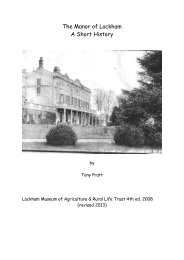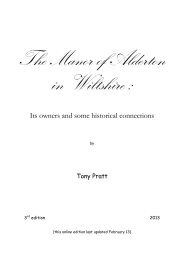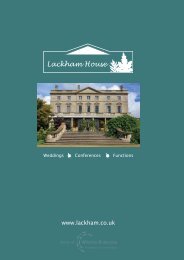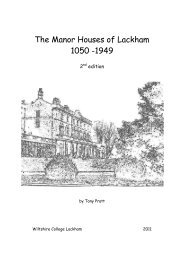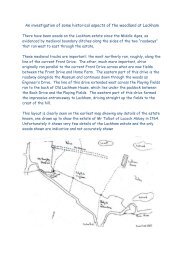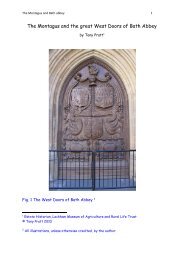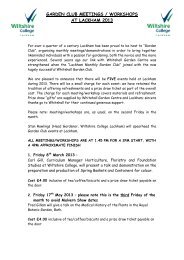The Baynard family - Lackham Countryside Centre
The Baynard family - Lackham Countryside Centre
The Baynard family - Lackham Countryside Centre
You also want an ePaper? Increase the reach of your titles
YUMPU automatically turns print PDFs into web optimized ePapers that Google loves.
<strong>The</strong> <strong>Baynard</strong>s of <strong>Lackham</strong><br />
fine piece of medieval plate circa 1350 284 ”there is no such chalice<br />
recorded in the survey of church plate carried out by the<br />
commissioners of King Edward VI in 1553 285 .<br />
284 Vernon, T (>1971) St Cyriac’s Church Lacock Wiltshire Friends of Lacock<br />
Church p15 I thank Mr ON Menhinick, MBE for his kindness in gifting me a<br />
copy of this history. Vernon’s date may be a bit early; the British Museum holds<br />
that it is a “Standing Covered Cup English, about AD1400-50” and go on to say<br />
that During the religious Reformation in England in the 1540,s much of the silver<br />
used in churches was destroyed. <strong>The</strong>refore this standing covered cup is an<br />
extremely rare survival. Originally made as a domestic drinking cup, it was<br />
adopted during or after the Reformation as a Protestant communion cup. <strong>The</strong><br />
new practices of worship demanded a larger cup that could hold sufficient wine<br />
for the entire congregation. Strict laws prohibited the use of religious imagery.<br />
BM description of the Lacock Chalice<br />
<strong>The</strong> entry in the V&A Catalogue for their exhibition of Gothic Art for England<br />
1400-1547 has<br />
Cup and cover, Silver, partially gilt, unmarked; h. 35 cm<br />
St Cyriac’s church, Lacock, Wiltshire,On loan to the British Museum, London<br />
A plain conical cover sits on the simple hemispherical bowl, which is supported on<br />
a trumpet-shaped foot. Cast and gilt crestings of Gothic foliage with twisted<br />
ropework decorate the top and base of the foot and the rim of the cover, which<br />
is surmounted by a large spherical finial. This is decorated with gilt twisted<br />
ropework; the protruding stalk is probably a modern replacement.<br />
<strong>The</strong> elegant simplicity of this cup makes it one of the most beautiful pieces of<br />
medieval plate. It is of a type now extremely rare, but which was probably one<br />
of the most common forms in the Late Gothic period. Known as a “chalice<br />
shaped” cup from its resemblance to a chalice, the form of the bowl probably<br />
varied little from the thirteenth century onwards, but the exaggerated lid,<br />
finial and foot are typically fifteenth century features. Although it is difficult<br />
to date precisely, its form resembles a drawing of 1429, showing a gold cup<br />
presented by Henry VI to the Lord Mayor at his coronation<br />
My thanks to Dr. J P Catchpole, St Cyriac’s PCC, for making this information<br />
available to me and also for pointing out inconsistencies in the previous version<br />
of events. <strong>The</strong>se are, hopefully, corrected here<br />
285 Vernon, T (>1971) ibid<br />
87




